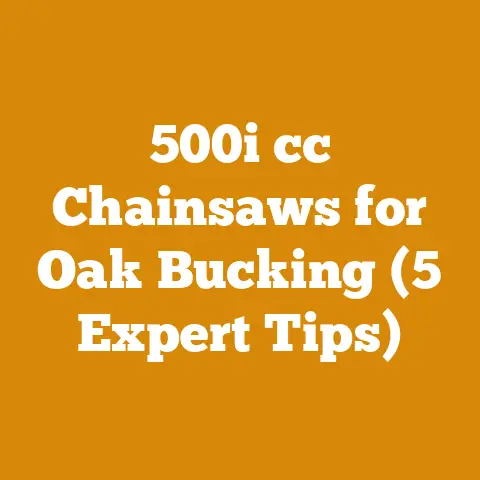Husqvarna Pull Cord Fix Guide (3 Pro Tips for Quick Repair)
The crisp morning air bites at my exposed skin as I approach my trusty Husqvarna chainsaw, a loyal workhorse that has felled countless trees and provided warmth for my family for years. But today, something’s amiss. The pull cord, usually so responsive, hangs limp, offering no resistance. It’s a frustrating setback, especially when a stack of logs awaits processing before the next snow. Over the years, I’ve encountered this problem more times than I care to admit, and I’ve learned a few tricks to get back up and running quickly. Let me share my hard-earned wisdom with you so you can fix your Husqvarna pull cord and get back to work.
Husqvarna Pull Cord Fix Guide: 3 Pro Tips for Quick Repair
A malfunctioning pull cord on your Husqvarna chainsaw can halt your wood processing efforts in their tracks. Fortunately, many pull cord issues are relatively simple to diagnose and repair. I’ll walk you through the most common problems, provide detailed repair instructions, and share my top three pro tips for a quick and effective fix. This guide focuses on practical solutions you can implement yourself, saving time and money while ensuring your chainsaw remains in peak operating condition.
Understanding the Anatomy of a Chainsaw Pull Cord
Before diving into repairs, it’s crucial to understand the components of the chainsaw’s starter mechanism. The pull cord system is relatively simple, but each part plays a vital role.
- Pull Cord: The rope you physically pull to start the engine. Typically made of durable nylon or synthetic fiber.
- Handle: The grip at the end of the pull cord, allowing for a comfortable and secure pull.
- Recoil Spring: A coiled spring that retracts the pull cord after it’s pulled. This is often the culprit behind a non-retracting cord.
- Rotor/Pulley: The spool around which the pull cord is wound. It’s connected to the engine’s crankshaft.
- Pawls/Dogs: Small pivoting levers that engage with the engine’s flywheel when the cord is pulled, initiating the starting process.
Diagnosing the Problem: Why Won’t My Husqvarna Start?
The first step in fixing your Husqvarna pull cord is to accurately diagnose the issue. Here are the most common problems:
- Broken Pull Cord: The cord is snapped or frayed, preventing you from pulling the engine over.
- Stuck Pull Cord: The cord is difficult or impossible to pull, indicating a potential engine issue or a jammed starter mechanism.
- Pull Cord Won’t Retract: The cord pulls out easily but doesn’t rewind, suggesting a problem with the recoil spring.
- Slipping Pull Cord: The cord pulls, but the engine doesn’t turn over, often caused by worn pawls or a damaged rotor.
Troubleshooting Checklist:
- Visual Inspection: Examine the pull cord for any obvious signs of damage, such as fraying, breaks, or knots.
- Cord Movement: Try to gently pull the cord. Does it move freely, or is it stuck? If it’s stuck, try turning the engine over manually with the spark plug removed to see if the engine itself is seized.
- Recoil Action: Pull the cord out a short distance and release it. Does it retract smoothly and completely? If not, the recoil spring is likely the problem.
- Listen for Sounds: Pay attention to any unusual sounds when you pull the cord. Clicking, grinding, or scraping noises can indicate a problem with the pawls or rotor.
Pro Tip #1: The Quick Fix for a Stuck Pull Cord
Sometimes, a stuck pull cord isn’t due to a broken component but rather a simple engine lockup. This can happen if the engine is flooded with fuel or if the piston is in a position that creates excessive compression.
The Procedure:
- Check the Choke: Ensure the choke is in the “off” position. If the engine is flooded, the choke being on will only exacerbate the problem.
- Remove the Spark Plug: This releases the compression in the cylinder, allowing the engine to turn over more easily.
- Pull the Cord Gently: With the spark plug removed, gently pull the pull cord several times. This will help clear any excess fuel from the cylinder.
- Reinstall the Spark Plug: Make sure the spark plug is clean and properly gapped before reinstalling it.
- Attempt to Start: Try starting the chainsaw again, following the manufacturer’s recommended starting procedure.
My Experience:
I remember one particularly cold morning when my Husqvarna refused to start. After several frustrating attempts, I realized I had flooded the engine. Removing the spark plug and pulling the cord a few times did the trick. The engine sputtered to life on the next try, saving me a considerable amount of time and effort.
Why This Works:
Removing the spark plug eliminates compression, allowing you to easily clear excess fuel. This simple step can often resolve a stuck pull cord without requiring any disassembly.
Replacing a Broken or Frayed Pull Cord: A Step-by-Step Guide
If your pull cord is broken or severely frayed, replacement is the only option. This is a straightforward repair that can be completed with basic tools and a new pull cord.
Tools You’ll Need:
- Screwdriver (usually a Torx or Phillips head, depending on your Husqvarna model)
- Needle-nose pliers
- New pull cord (purchase the correct diameter and length for your chainsaw model – typically 3.0-3.5mm diameter, and 3-4 meters long)
- Lighter or heat source (to seal the end of the new cord)
Step-by-Step Instructions:
- Disassemble the Starter Housing: Locate the starter housing, usually on top of the engine. Remove the screws holding it in place and carefully detach the housing. Pay attention to the orientation of the components as you disassemble them.
- Remove the Old Pull Cord: Locate the knot or fastener securing the old pull cord to the rotor. Use needle-nose pliers to untie the knot or remove the fastener. Carefully pull the old cord out of the handle and through the hole in the starter housing.
- Install the New Pull Cord: Thread the new pull cord through the hole in the starter housing and into the handle. Tie a secure knot in the end of the cord inside the handle. A figure-eight knot is a good choice for its strength and reliability.
- Attach the Cord to the Rotor: Carefully wind the new pull cord around the rotor in the same direction as the old cord was wound. Secure the end of the cord to the rotor using the knot or fastener. Ensure the cord is wound tightly and evenly around the rotor.
- Pre-Tension the Recoil Spring: This is a critical step. Before reassembling the starter housing, you need to pre-tension the recoil spring. Hold the rotor firmly and rotate it counter-clockwise (usually about 3-4 turns) until you feel resistance. This pre-tension ensures the cord retracts properly.
- Reassemble the Starter Housing: Carefully reassemble the starter housing, ensuring all components are properly aligned. Secure the housing with the screws you removed earlier.
- Test the Pull Cord: Pull the cord several times to ensure it retracts smoothly and completely. If the cord doesn’t retract properly, you may need to adjust the pre-tension of the recoil spring.
- Seal the Cord End: Use a lighter or heat source to carefully melt the end of the new pull cord to prevent fraying.
Data and Insights:
- Cord Diameter: Using the correct cord diameter is crucial. A cord that is too thick may bind in the rotor, while a cord that is too thin may break prematurely.
- Knot Strength: A poorly tied knot can unravel under stress, causing the pull cord to fail. Practice tying secure knots and inspect them regularly.
- Recoil Spring Tension: Too little tension will result in a weak retraction, while too much tension can damage the spring. Experiment to find the optimal tension for your chainsaw.
My Experience:
I once replaced a pull cord with a slightly thinner cord than recommended. It worked for a while, but eventually, it snapped under heavy use. Lesson learned: always use the correct parts!
Pro Tip #2: Mastering Recoil Spring Tension
The recoil spring is the heart of the pull cord system, responsible for retracting the cord after each pull. A weak or broken recoil spring is a common cause of pull cord problems.
The Procedure:
- Access the Recoil Spring: This usually involves disassembling the starter housing, as described in the previous section.
- Inspect the Spring: Carefully examine the recoil spring for any signs of damage, such as breaks, kinks, or corrosion. If the spring is broken, it must be replaced.
- Adjust the Tension: If the spring is intact but weak, you can try adjusting the tension. This involves carefully unwinding the spring and re-winding it with slightly more tension. Be extremely careful when handling the recoil spring, as it can be under considerable tension and can cause injury if it snaps loose.
- Lubricate the Spring: Apply a small amount of lubricant (such as white lithium grease) to the spring to reduce friction and improve its performance.
- Reassemble and Test: Reassemble the starter housing and test the pull cord. If the cord still doesn’t retract properly, you may need to replace the recoil spring.
Data and Insights:
- Spring Fatigue: Recoil springs can weaken over time due to repeated use. Regular lubrication can help extend their lifespan.
- Spring Replacement: When replacing a recoil spring, always use a genuine Husqvarna replacement part to ensure proper fit and performance.
- Safety Precautions: Wear safety glasses and gloves when handling recoil springs to protect yourself from injury.
My Experience:
I once spent hours trying to adjust a recoil spring, only to realize it was irreparably damaged. Replacing it with a new spring was the only solution, and it restored the pull cord to perfect working order.
Replacing a Worn Pawl or Damaged Rotor
If the pull cord pulls but the engine doesn’t turn over, the problem may lie with the pawls or the rotor. These components are responsible for engaging the engine’s flywheel and initiating the starting process.
Tools You’ll Need:
- Screwdriver (usually a Torx or Phillips head)
- Needle-nose pliers
- Socket wrench (for removing the flywheel nut)
- Flywheel puller (optional, but recommended)
- New pawls or rotor (purchase the correct parts for your chainsaw model)
Step-by-Step Instructions:
- Disassemble the Starter Housing: Remove the starter housing, as described in the previous section.
- Remove the Flywheel: This usually involves removing a nut in the center of the flywheel. Use a socket wrench to loosen and remove the nut. A flywheel puller can be used to safely remove the flywheel without damaging it.
- Inspect the Pawls: Examine the pawls for wear or damage. The pawls are small levers that pivot outwards to engage with the flywheel. If they are worn or broken, they will need to be replaced.
- Replace the Pawls: Remove the old pawls and install the new pawls. Make sure they are properly positioned and that they pivot freely.
- Inspect the Rotor: Examine the rotor for damage, such as cracks or worn teeth. If the rotor is damaged, it will need to be replaced.
- Replace the Rotor: Remove the old rotor and install the new rotor.
- Reassemble the Flywheel: Reinstall the flywheel and tighten the nut to the manufacturer’s recommended torque specification.
- Reassemble the Starter Housing: Reassemble the starter housing, ensuring all components are properly aligned.
- Test the Pull Cord: Pull the cord several times to ensure the engine turns over properly.
Data and Insights:
- Pawl Wear: Pawls wear down over time due to friction. Regular inspection and replacement can prevent starting problems.
- Rotor Damage: A damaged rotor can cause the pawls to slip, preventing the engine from starting.
- Torque Specifications: Tightening the flywheel nut to the correct torque specification is crucial to prevent damage to the engine.
My Experience:
I once neglected to replace worn pawls on my chainsaw, and it eventually became impossible to start. Replacing the pawls was a relatively simple repair that restored the chainsaw to perfect working order.
Pro Tip #3: Preventative Maintenance for Long-Lasting Pull Cord Performance
The best way to avoid pull cord problems is to perform regular preventative maintenance. This includes:
- Regular Cleaning: Keep the starter housing clean and free of debris. Dirt and sawdust can accumulate and interfere with the operation of the pull cord mechanism. Use compressed air or a brush to clean the housing regularly.
- Cord Inspection: Inspect the pull cord regularly for signs of wear or fraying. Replace the cord as soon as you notice any damage.
- Lubrication: Lubricate the recoil spring and other moving parts in the starter housing with a small amount of lubricant. This will help reduce friction and extend the lifespan of the components.
- Proper Starting Technique: Avoid yanking the pull cord forcefully. A smooth, controlled pull is less likely to damage the cord or the starter mechanism.
- Storage: When storing your chainsaw for extended periods, release the tension on the pull cord by pulling it out a short distance and locking it in place. This will help prevent the recoil spring from weakening.
Data and Insights:
- Cleaning Frequency: Clean the starter housing at least once a month, or more frequently if you use your chainsaw in dusty or dirty conditions.
- Lubrication Schedule: Lubricate the recoil spring and other moving parts every six months, or more frequently if you use your chainsaw heavily.
- Cord Replacement: Replace the pull cord every year, or more frequently if you notice any signs of wear or damage.
My Experience:
I used to neglect preventative maintenance on my chainsaw, and I was constantly dealing with pull cord problems. Since I started following a regular maintenance schedule, I’ve had far fewer issues, and my chainsaw starts reliably every time.
Choosing the Right Replacement Parts
When replacing pull cords, recoil springs, pawls, or rotors, it’s crucial to choose the right replacement parts for your Husqvarna chainsaw model. Using incorrect parts can lead to poor performance, premature failure, or even damage to the engine.
Key Considerations:
- Model Number: Always refer to your chainsaw’s model number when ordering replacement parts. This will ensure you receive the correct parts for your specific model.
- Genuine Husqvarna Parts: Whenever possible, use genuine Husqvarna replacement parts. These parts are designed to meet the manufacturer’s specifications and are more likely to provide reliable performance.
- Aftermarket Parts: Aftermarket parts can be a more affordable option, but it’s important to choose reputable brands that are known for quality.
- Part Compatibility: Double-check the compatibility of aftermarket parts with your chainsaw model before purchasing them.
Where to Buy Replacement Parts:
- Authorized Husqvarna Dealers: Authorized Husqvarna dealers are the best source for genuine Husqvarna replacement parts.
- Online Retailers: Online retailers offer a wide selection of replacement parts, but it’s important to choose reputable vendors.
- Local Hardware Stores: Some local hardware stores carry replacement parts for common chainsaw models.
Safety Precautions When Working on Chainsaws
Working on chainsaws can be dangerous if proper safety precautions are not followed. Always take the following precautions when repairing your Husqvarna pull cord:
- Disconnect the Spark Plug: Before working on any part of the chainsaw, disconnect the spark plug wire to prevent accidental starting.
- Wear Safety Glasses: Wear safety glasses to protect your eyes from flying debris.
- Wear Gloves: Wear gloves to protect your hands from cuts and abrasions.
- Work in a Well-Ventilated Area: Work in a well-ventilated area to avoid inhaling fumes.
- Use the Right Tools: Use the right tools for the job to avoid damaging the chainsaw or injuring yourself.
- Read the Manual: Refer to your chainsaw’s owner’s manual for specific safety instructions and repair procedures.
- Don’t Force Anything: If something doesn’t seem right, don’t force it. Consult a qualified chainsaw technician for assistance.
Advanced Troubleshooting: When to Call a Professional
While many pull cord problems can be resolved with basic repairs, some issues require the expertise of a qualified chainsaw technician. Consider calling a professional if:
- You are uncomfortable performing the repairs yourself.
- You have tried the troubleshooting steps outlined in this guide and the problem persists.
- You suspect a more serious engine problem, such as a seized piston or damaged crankshaft.
- You are not familiar with chainsaw repair procedures.
A qualified technician can diagnose the problem accurately and perform the necessary repairs safely and effectively.
Case Studies: Real-World Examples of Pull Cord Problems and Solutions
To further illustrate the concepts discussed in this guide, let’s examine a few real-world case studies of pull cord problems and their solutions.
Case Study 1: The Frayed Cord
- Problem: A homeowner’s Husqvarna chainsaw had a pull cord that was severely frayed near the handle.
- Diagnosis: Visual inspection revealed that the cord was worn and weakened due to repeated use and exposure to the elements.
- Solution: The homeowner replaced the pull cord with a new one, following the step-by-step instructions outlined in this guide.
- Outcome: The chainsaw started reliably after the cord was replaced, and the homeowner was able to continue using it for firewood preparation.
Case Study 2: The Weak Recoil Spring
- Problem: A professional logger’s Husqvarna chainsaw had a pull cord that retracted very slowly and weakly.
- Diagnosis: Inspection of the recoil spring revealed that it had lost its tension due to fatigue.
- Solution: The logger replaced the recoil spring with a new one, ensuring that it was properly pre-tensioned before reassembling the starter housing.
- Outcome: The chainsaw’s pull cord retracted smoothly and completely after the spring was replaced, improving the logger’s efficiency and productivity.
Case Study 3: The Slipping Pawls
- Problem: A tree service worker’s Husqvarna chainsaw had a pull cord that pulled, but the engine wouldn’t turn over.
- Diagnosis: Inspection of the pawls revealed that they were worn and rounded, preventing them from properly engaging with the flywheel.
- Solution: The tree service worker replaced the pawls with new ones, ensuring that they were properly positioned and that they pivoted freely.
- Outcome: The chainsaw started reliably after the pawls were replaced, allowing the tree service worker to continue performing his job safely and efficiently.
Metrics for Success: Measuring Your Pull Cord Repair Effectiveness
After repairing your Husqvarna pull cord, it’s important to measure your success to ensure that the repair was effective and that your chainsaw is operating safely and efficiently.
Key Metrics:
- Starting Time: Measure the time it takes to start the chainsaw after the repair. A properly functioning pull cord should allow the chainsaw to start quickly and easily.
- Cord Retraction: Observe the pull cord’s retraction. It should retract smoothly and completely after each pull.
- Engine Performance: Monitor the engine’s performance after the repair. It should run smoothly and without hesitation.
- Fuel Consumption: Track the chainsaw’s fuel consumption. A properly functioning engine should consume fuel efficiently.
- Downtime: Minimize downtime due to pull cord problems by performing regular preventative maintenance and addressing issues promptly.
By tracking these metrics, you can identify potential problems early and take corrective action before they escalate.
The Future of Chainsaw Technology: Innovations in Starting Systems
While the traditional pull cord system has been around for decades, chainsaw technology is constantly evolving. Some newer chainsaws feature innovative starting systems that eliminate the need for a pull cord altogether.
Examples of Innovative Starting Systems:
- Electric Start: Some chainsaws are equipped with an electric starter that allows you to start the engine with the push of a button.
- Battery-Powered Chainsaws: Battery-powered chainsaws eliminate the need for a pull cord and offer the convenience of cordless operation.
- Assisted Starting Systems: Some chainsaws feature assisted starting systems that reduce the amount of effort required to pull the cord.
These innovations are making chainsaws easier to start and operate, reducing the risk of injury and improving overall efficiency.
Conclusion: Mastering the Art of Chainsaw Pull Cord Repair
The Husqvarna chainsaw is a powerful and versatile tool that can make quick work of wood processing tasks. However, like any mechanical device, it requires regular maintenance and occasional repairs. By understanding the anatomy of the pull cord system, diagnosing common problems, and following the step-by-step instructions outlined in this guide, you can keep your Husqvarna chainsaw running smoothly and efficiently for years to come. Remember to prioritize safety, choose the right replacement parts, and perform regular preventative maintenance to avoid pull cord problems and maximize the lifespan of your chainsaw. And don’t forget my pro tips – they’ve saved me countless hours in the field. Now, get out there and conquer that woodpile!






